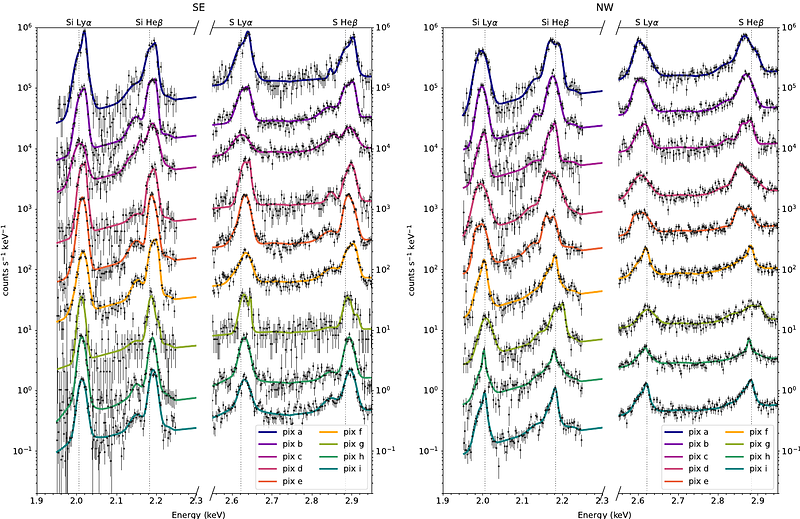Mapping Cassiopeia A's silicon/sulfur Doppler velocities with XRISM-Resolve

Mapping Cassiopeia A's silicon/sulfur Doppler velocities with XRISM-Resolve
Jacco Vink Anton Pannekoek Institute/GRAPPA, University of Amsterdam, Netherlands SRON Netherlands Institute for Space Research, Leiden, Netherlands, Manan Agarwal Anton Pannekoek Institute/GRAPPA, University of Amsterdam, Netherlands, Aya Bamba Department of Physics, Graduate School of Science, The University of Tokyo, Japan Research Center for the Early Universe, School of Science, The University of Tokyo, Japan Trans-Scale Quantum Science Institute, The University of Tokyo, Japan, Liyi Gu SRON Netherlands Institute for Space Research, Leiden, Netherlands, Paul Plucinsky Harvard-Smithsonian Center for Astrophysics, Cambridge MA, USA, Ehud Behar Department of Physics, Technion, Technion City, Haifa, Israel, Lia Corrales Department of Astronomy, University of Michigan, USA, Adam Foster Harvard-Smithsonian Center for Astrophysics, Cambridge MA, USA, Shin-ichiro Fujimoto National Institute of Technology Kumamoto College, Kumamoto, Japan, Masahiro Ichihashi Department of Physics, Graduate School of Science, The University of Tokyo, Japan, Kazuhiro Ichikawa Faculty of Engineering, University of Miyazaki, Miyazaki, Japan, Satoru Katsuda Graduate School of Science and Engineering, Saitama University, Saitama, Japan, Hironori Matsumoto Department of Earth and Space Science, Osaka University, Osaka, Japan, Kai Matsunaga Department of Physics, Kyoto University, Kyoto, Japan, Tsunefumi Mizuno Department of Physics, Hiroshima University, Hiroshima, Japan, Koji Mori Faculty of Engineering, University of Miyazaki, Miyazaki, Japan, Hiroshi Murakami Department of Data Science, Tohoku Gakuin University, Miyagi, Japan, Hiroshi Nakajima College of Science and Engineering, Kanto Gakuin University, Kanagawa, Japan, Toshiki Sato School of Science and Technology, Meiji University, Kanagawa, Japan, Makoto Sawada Department of Physics, Rikkyo University, Tokyo, Japan, Haruto Sonoda ISAS/JAXA, Sagamihara, Kanagawa, Japan, Shunsuke Suzuki ISAS/JAXA, Sagamihara, Kanagawa, Japan, Dai Tateishi Department of Physics, Graduate School of Science, The University of Tokyo, Japan Present address: Collaborative Laboratories for Advanced Decommissioning Science, Japan Atomic Energy Agency, Fukushima, Japan, Yukikatsu Terada Graduate School of Science and Engineering, Saitama University, Saitama, Japan ISAS/JAXA, Sagamihara, Kanagawa, Japan, Hiroyuki Uchida Department of Physics, Kyoto University, Kyoto, Japan
AbstractYoung supernova remnants (SNRs) provide crucial insights into explosive nucleosynthesis products and their velocity distribution soon after the explosion. However, these velocities are influenced by the dynamics of the circumstellar medium (CSM), which originates from the progenitor's late-phase mass loss. Cas A, the youngest known Galactic core-collapse SNR, was studied to analyze the spatial distribution of Si and S radial velocities using two high-spectral resolution observations from the XRISM-Resolve imaging spectrometer.Resolve's capabilities enabled the detailed characterization of Si XIII, Si XIV, S XV, and S XVI lines, whose line shapes can be resolved and modeled using Gaussian radial-velocity components. The radial velocities measured generally align with previous CCD-based results, confirming that they were not artifacts caused by blended lines or ionization variations. Modeling line profiles with two-component Gaussians improved fits in some regions, revealing distinct redshifted (backside) and blueshifted (frontside) components only in a few specific areas. In most regions, however, both components were either both redshifted (northwest) or both blueshifted (southeast), consistent with the patchy ejecta shell morphology seen in optically emitting fast-moving knots. The individual line components revealed a line broadening ranging from $\sigma_v \approx 200$ to $\sigma_v \approx 2000$ km/s. Components with $1000 \lesssim \sigma_v \lesssim 2000$km/s are consistent with previously determined reverse shock velocities, suggesting non-equilibrated or partially equilibrated ion temperatures. Narrow components with small radial velocities found near Cas A's projected center likely originate from shocked CSM plasma. But the low radial velocity and small $\sigma_v$ defies identifying these components with either the frontside or backside of the SNR, or both.